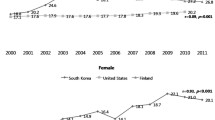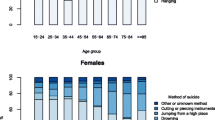Abstract
Adoption of assisted dying has rapidly grown, but many groups caution that these policies can cause suicide contagions. If those urging caution are correct, jurisdictions with these policies will experience increased suicides. This study aimed to determine the changes in population suicide rates in Belgium before and after its 2002 policy using the synthetic control method (SCM) and generalized synthetic control method (GSCM). As comparisons we used additional European Union members that have not adopted these policies. GSCM showed an average annual suicide rate increase of 0.73 per 100,000 population (95% CI − 5.7 to 7.2; p = 0.80). Placebo testing based on the SCM analysis showed equal outcomes for Belgium and the comparisons. This study failed to show evidence of association between implementation of legislation legitimizing assisted dying and population suicide rates. The threat of suicide contagion has influenced policy discussions in the past, but this study suggests that there is presently no indication for policy-makers to view suicide contagions as a concerning side effect of assisted dying legislation.



Similar content being viewed by others
References
Cheng Q, Li H, Silenzio V, Caine E. Suicide contagion: a systematic review of definitions and research utility. PLoS ONE. 2014;9(9):e108724.
Gould M, Lake A. The contagion of suicidal behaviour. In: Contagion of violence-workshop summary. Washington, DC: National Academies Press; 2013
Jang SA, Sung JM, Park JY, Jeon WT. Copycat suicide induced by entertainment celebrity suicides in South Korea. Psychiatry Investig. 2016;13(1):74–81.
Stack S. Media coverage as a risk factor in suicide. J Epidemiol Community Heal. 2003;57(4):238–40.
Callahan J. The ethics of assisted suicide. Health Soc Work. 1994;19(4):237–44.
Dunn L. From, “Delete Your Account” to “Delete Yourself”: legislated suicide and the Role of psychiatry. Psychiatr Times. 2017;34(5):1–3.
Jones D, Paton D. How does legalization of physician-assisted suicide affect rates of suicide? South Med J. 2015;108(10):599–604.
Kheriaty A. Social contagion effects of physician-assisted suicide: commentary on "How does legalization of physician-assisted suicide affect rates of suicide?". South Med J. 2015;108(10):605–6.
Nicol J, Tiedemann M. Euthanasia and assisted suicide: the law in selected countries. Libr Parliam Res Publ; 2015. p. 116
Hawton K, van Heeringen K. Suicide Lancet. 2009;373(9672):1372–81.
Cavanagh JTO, Carson AJ, Sharpe M, Lawrie SM. Psychological autopsy studies of suicide: a systematic review. Psychol Med. 2003;33(3):395–405.
Francis N. The ten deadly sins of Jones, Paton and Kheriaty on ‘suicide contagion’. Dying for Choice. 2017. https://www.dyingforchoice.com/docs/TheTenDeadlySinsOfJonesPatonAndKheriaty2017.pdf.
Shen X, Millet L. Suicides in Oregon: trends and associated factors 2003–2012. Oregon Health Authority. 2012. https://www.oregon.gov/oha/PH/DISEASESCONDITIONS/INJURYFATALITYDATA/Documents/NVDRS/SuicideinOregon2015report.pdf.
McKenzie K, Andrew MK, Chandler JA, Deschamps P, Downie J, Drapeau M, et al. The state of knowledge on medical assistance in dying where a mental disorder is the sole underlying medical condition. Council of Canadian Academies. 2018. https://scienceadvice.ca/wp-content/uploads/2018/10/Medical-Assistance-in-Dying.zip.
Xu Y. Generalized synthetic control method: causal inference with interactive fixed effects models. Polit Anal. 2017;25(1):57–76.
Abadie A, Diamond A, Hainmueller J. Synthetic control methods for comparative case studies: estimating the effect of California’s tobacco control program. J Am Stat Assoc. 2010;105(490):493–505.
Abadie A, Diamond A, Hainmueller J. Comparative politics and the synthetic control method. Am J Pol Sci. 2015;59(2):495–510.
Bai J. Panel data models with interactive fixed effects. Econometrica. 2009;77(4):1229–79.
Bouttell J, Craig P, Lewsey J, Robinson M, Popham F. Synthetic control methodology as a tool for evaluating population-level health interventions. J Epidemiol Community Health. 2018;72(8):673–8.
Suicide rates (indicator). OECD. 2019. https://data.oecd.org/healthstat/suicide-rates.htm.
Andriessen K, Krysinska K, Lester D. Predicting the natural suicide rate in Belgium. Suicidol Online. 2015;6(1):15–20.
Bernal M, Haro JM, Bernert S, Brugha T, de Graaf R, Bruffaerts R, et al. Risk factors for suicidality in Europe: results from the ESEMED study. J Affect Disord. 2007;101(1–3):27–34.
Maag T. Economic correlates of suicide rates in OECD countries. KOF Work Pap. 2008; 207. https://papers.ssrn.com/sol3/papers.cfm?abstract_id=1265087.
Dauber MS. An analysis of New York state’s Medical Aid in Dying Act (A. 2383A S. 3151). Voices in Bioethics. n.d. https://www.voicesinbioethics.net/voices-in-bioethics/2018/5/3/an-analysis-of-new-york-states-medical-aid-in-dying-act-a-2383a-s-3151.
Francis N. Parliament of Western Australia joint select committee on end of life choices. Dying for Choice. 2017. https://www.dyingforchoice.com/docs/DfC-WAParliamentSubmission-2017-10-03.pdf.
Hollinger D, Mason K. Drs. Hollinger and Mason testify on House Bill 119A, relative to end of life options. Gordon Conwell Theological Seminary. 2017. https://www.gordonconwell.edu/campusuite/modules/blog.cfm?blog_seo_file=Drs-Hollinger-and-Mason-testify-on-House-Bill-119A-relative-to-end-of-life-options&blog_grp_folder=&post_year=2017&post_month=10&fbclid=IwAR1RoYjjSlGhHktvw2kHeGueP3BaPvHmlEDeL7_ebZv08.
Karapetis CS, Stein B, Koczwara B, Harrup R, Milleshkin L, Parente P, et al. Medical Oncology Group of Australia position statement and membership survey on voluntary assisted dying. Intern Med J. 2018;48(7):774–9.
Kheriaty A. Letter from Dr. Aaron Kheriaty, M.D., to the American Medical Association. Charlotte Lozier Institute. 2015. https://s27589.pcdn.co/wp-content/uploads/2017/02/Kheriaty-AMA-letter-1.pdf.
Mulino D. Inquiry into end of life choices final report: Minority report by Daniel Mulino, member for Eastern Victoria Region. 2016. https://www.cam.org.au/Portals/71/MinorityReportbyDanielMulino.pdf.
Sulmasy LS, Mueller PS. Ethics and the legalization of physician-assisted suicide: an american college of physicians position paper. Ann Intern Med. 2017;167(8):576–8.
Lukaschek K, Engelhardt H, Baumert J, Ladwig KH. No correlation between rates of suicidal ideation and completed suicides in Europe: analysis of 49,008 participants (55+ years) based on the Survey of Health, Ageing and Retirement in Europe (SHARE). Eur Psychiatry. 2015;30(7):874–9.
Rogers ML, Ringer FB, Joiner TE. The association between suicidal ideation and lifetime suicide attempts is strongest at low levels of depression. Psychiatry Res. 2018;270:324–8.
Thienpont L, Verhofstadt M, Loon TV, Distelmans W, Audenaert K, Deyn P. Euthanasia requests, procedures and outcomes for 100 Belgian patients suffering from psychiatric disorders: a retrospective, descriptive study. BMJ Open. 2015;5(7):e007454.
Funding
This research did not receive any specific grant from funding agencies in the public, commercial, or not-for-profit sectors.
Author information
Authors and Affiliations
Corresponding author
Ethics declarations
Conflict of interest
I am a volunteer member of the Disability Advisory Council, a group that operates under Dying with Dignity Canada (DWDC). DWDC is a Canadian organization with charitable status that advocates for all aspects of end of life care, including medical assistance in dying. DWDC, its staff, its volunteers, and other members of DWDC have no relationship to, did not contribute to, and provided no support with any aspect of this article. This article is entirely my personal endeavour.
Ethics approval
This study did not include human participants. Data were obtained from free and open access databases.
Additional information
Publisher's Note
Springer Nature remains neutral with regard to jurisdictional claims in published maps and institutional affiliations.
Electronic supplementary material
Below is the link to the electronic supplementary material.
Rights and permissions
About this article
Cite this article
Nanner, H. The effect of assisted dying on suicidality: a synthetic control analysis of population suicide rates in Belgium. J Public Health Pol 42, 86–97 (2021). https://doi.org/10.1057/s41271-020-00249-8
Published:
Issue Date:
DOI: https://doi.org/10.1057/s41271-020-00249-8




